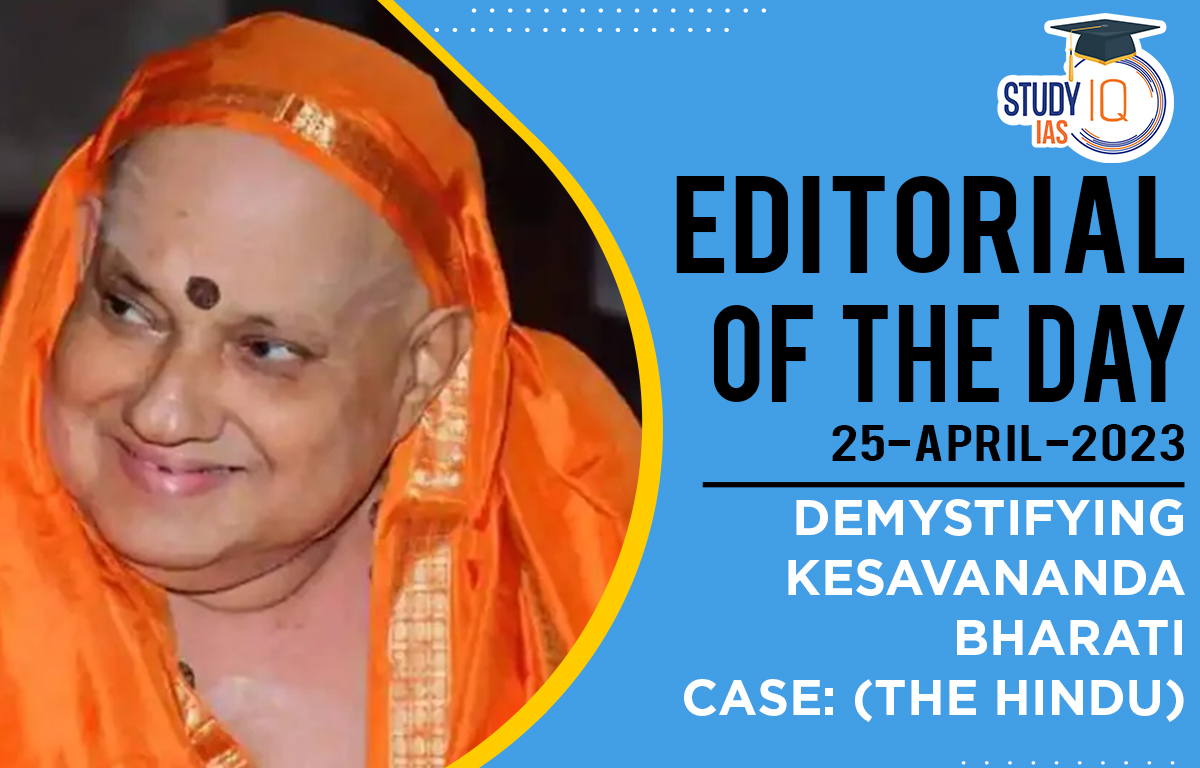Table of Contents
Context: The article is discussing the landmark Kesavananda Bharati vs State of Kerala case, which recently marked its 50 years of completion. The case is known for its establishment of the concept of the basic structure doctrine (which includes democracy, secularism, federalism, independence of the judiciary, and power of judicial review by superior courts) of the Indian Constitution. The article highlights its unique facets such as being the longest argued case with the largest bench (13 judges) of the Supreme Court and establishment of a permanent bulwark against tyranny and dictatorship and that Parliament can amend any part of the Constitution as long as it does not alter or amend the basic structure or essential features of the Constitution.
Demystifying Kesavananda Bharati Case Background
Kesavananda Bharati vs State of Kerala Case 1973:
- In Kesavananda Bharati case, a relief was sought against the Kerala government vis-à-vis two state land reform laws, which imposed restrictions on the management of religious property..
- The case was challenged under Article 26, concerning the right to manage religiously owned property without government interference.
- However, the case went beyond the issue of land acquisition and became a defining moment in Indian constitutional history.
- Question underlying the case: Was the power of Parliament to amend the Constitution unlimited? In other words, could Parliament alter, amend, abrogate any part of the Constitution even to the extent of taking away all fundamental rights?
- The Constitutional Bench of the Supreme Court ruled by a 7-6 verdict that Parliament could amend any part of the Constitution so long as it did not alter or amend the basic structure or essential features of the Constitution.
- However, the court did not define the term ‘basic structure’, and only listed a few principles such as federalism, secularism, democracy etc — as being its part.
Basic Structure Doctrine:
- The basic structure doctrine is a legal principle that exists in common law, which states that the constitution of a sovereign state has certain fundamental features or characteristics that are essential and cannot be altered or erased by its legislature through the process of amendment.
- The features of basic structure include democracy, secularism, federalism, independence of the judiciary, and the power of judicial review by superior courts, etc.
- The term “Basic Structure” is not explicitly mentioned in the Constitution but it is a concept that has been developed by the Indian judiciary to protect and preserve the underlying principles and values of the constitution.
- The basic structure doctrine is intended to ensure that the Constitution of India remains true to its original intent and purpose, and that it continues to protect the rights and freedoms of citizens, even in the face of attempts to alter or amend the Constitution.
Origin of the Basic Structure Doctrine in Indian Constitution

Evolution of the Basic Structure Doctrine in Indian Constitution

Elements of the Basic Structure Doctrine
The ‘basic structure’ doctrine has been interpreted so far to include:
- The supremacy of the Constitution
- The rule of law
- Independence of the judiciary
- Doctrine of separation of powers
- Sovereign democratic republic
- The parliamentary system of government
- The principle of free and fair elections
- Welfare state, etc.
Decoding the Editorial
The article is discussing the landmark verdict by the Supreme Court in Kesavananda Bharati case, 1973 regarding the power of Parliament to amend the Constitution.
- The Verdict: The verdict states that Parliament can amend any part of the Constitution as long as it does not alter or amend the basic structure or essential features of the Constitution.
- Also, the superior courts will have the last word on a case-by-case basis to decide the contours of basic structure.
- The basic structure features are not exhaustively itemized but an illustrative list has been provided which includes democracy, one-person-one-vote, secularism, federalism, republicanism, independence of the judiciary, and power of judicial review by superior courts.
- Shankari Prasad (1951) and Sajjan Singh (1964) cases: These cases dealt with the power of the Indian Parliament to amend the Constitution, particularly with respect to fundamental rights.
- In the Shankari Prasad (1951), the court upheld the validity of the first constitutional amendment, which had made inroads into property rights unchallengeable.
- The Supreme Court held that the power of amending the Constitution under Article 368 included the power to amend fundamental rights guaranteed in Part III of the Constitution.
- In the Sajjan Singh (1964) case, the court affirmed the earlier ruling and held that Parliament could amend any part of the Constitution, including the fundamental rights.
- In the Shankari Prasad (1951), the court upheld the validity of the first constitutional amendment, which had made inroads into property rights unchallengeable.
- Golaknath Case 1967: The Supreme Court, in the Golaknath case, held that fundamental rights were beyond the amending power of the Parliament, thus overruling the earlier decisions in Shankari Prasad and Sajjan Singh cases.
- The majority judgment in this case introduced the concept of implied limitations on the power of Parliament to amend the Constitution.
- According to this view, the Constitution grants a permanent place to the fundamental freedoms of the citizens, and when the people of India gave themselves the Constitution, they reserved these rights for themselves.
- Therefore, the fundamental rights enshrined in the Constitution cannot be taken away or altered by the Parliament through the amending process.
- This implies that there are certain limitations on the amending power of Parliament, which cannot be ignored while exercising that power.
- 24th to 26th Constitutional Amendments: The Parliament enacted the 24th to 26th in 1971 to overrule certain judgments made by the Supreme Court, including the bank nationalisation case, which held that the Constitution guaranteed the right to compensation, and the privy purses judgement, which abolished the privy purses of the erstwhile rulers of Indian princely states.
- These amendments were challenged in the name of Kesavananda Bharati, who was a mutt in Kerala.
- The case ultimately became known as the Kesavananda Bharati case and is considered one of the most important cases in Indian constitutional law.
- Kesavananda Bharati vs State of Kerala Case 1973:
- In Kesavananda Bharati case, a relief was sought against the Kerala government vis-à-vis two state land reform laws, which imposed restrictions on the management of religious property.
- The case was challenged under Article 26, concerning the right to manage religiously owned property without government interference.
- The Constitutional Bench of the Supreme Court ruled by a 7-6 verdict that Parliament could amend any part of the Constitution so long as it did not alter or amend the basic structure or essential features of the Constitution.
- However, the court did not define the term ‘basic structure’.
Beyond the Editorial
The Law Commission’s report, which was released in 2008, examined the concept of basic structure doctrine and made several recommendations to clarify and strengthen its application.
- Defining the basic structure: The report recommended that a list of basic features be prepared, which would help to clarify the scope and extent of the basic structure doctrine. The report suggested that these features could include democracy, the rule of law, judicial review, federalism, secularism, and the protection of fundamental rights.
- Reviewing constitutional amendments: The report recommended that any constitutional amendment that seeks to alter or affect the basic structure of the Constitution should be subject to stricter judicial scrutiny. It also suggested that the courts should be empowered to strike down any such amendment that violates the basic structure.
- Strengthening judicial independence: The report recommended measures to strengthen the independence of the judiciary, including the establishment of a National Judicial Commission to oversee the appointment and transfer of judges.
Similarly, the Second Administrative Reforms Commission’s report on “Ethics in Governance,” which was released in 2007, made several recommendations to strengthen the basic structure doctrine.
- Protecting fundamental rights: The report recommended that fundamental rights be protected as an essential component of the basic structure doctrine.
- Ensuring an independent judiciary: The report suggested measures to ensure the independence of the judiciary, including the establishment of a National Judicial Commission to oversee the appointment and transfer of judges.
- Ensuring federalism: The report recommended measures to protect the federal structure of the Constitution and to ensure that the powers of the central and state governments are clearly delineated.


 Article 142 of Indian Constitution, Sign...
Article 142 of Indian Constitution, Sign...
 Pakistan-Occupied Kashmir (PoK): History...
Pakistan-Occupied Kashmir (PoK): History...
 List of Indo-Pakistan Wars and Conflicts...
List of Indo-Pakistan Wars and Conflicts...





















